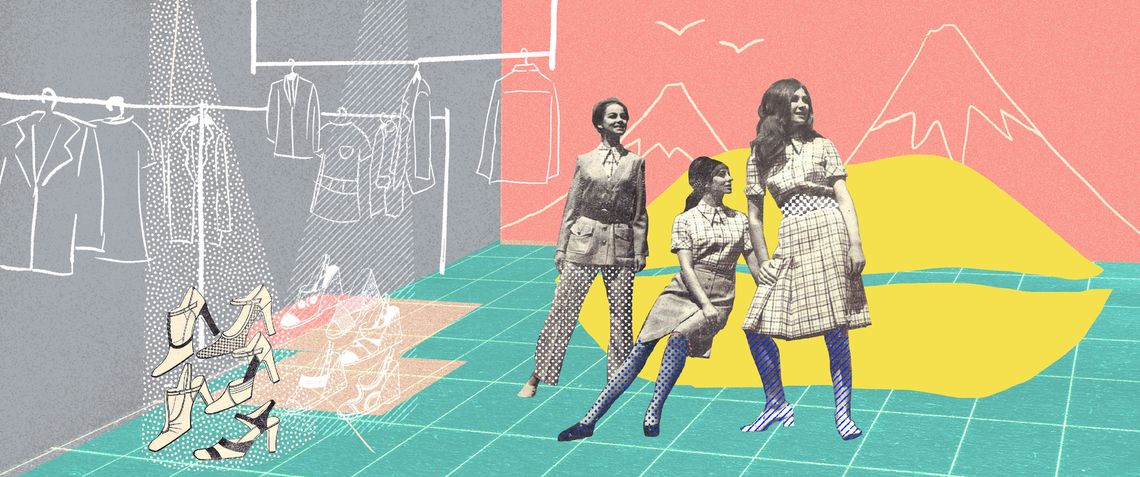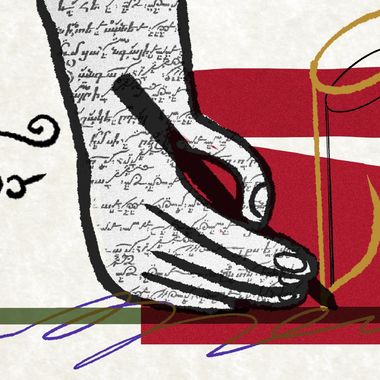Mon Mar 29 2021 · 7 min read
Back to the Future: The Evolution of Post-Soviet Aesthetic in Armenian Fashion

By Anais Gyulbudaghyan

Illustration by Armine Shahbazyan.
In Yerevan the boundaries of luxury and street style, tasteless and chic, high and low, have been merging and transforming for decades in the controversial post-Soviet space. Today, this new localism looks authentic in its otherworldliness and just like Berlin a couple of decades ago, it is poor but sexy.
Now, more than ever, the latest generation of Armenian designers is turning to the West to find sources of inspiration – and, imitation – for contemporary local couture. In fact, it was not until the early 2000s that Armenian fashion brands and designers came to be as such; during the last decades of 20th century, the local market was flooded by copies of Western designs and DIY imitations of a lifestyle, which everyone craved to have, but did not have direct access to.
The Armenian love for following trends is something that is a part of the collective cultural and political history. And that tendency became stronger after the collapse of the Soviet Union. There was a lack of everything. But people still aimed to live normally. In the USSR, fashion had to be distinct from Western designs in order to emphasize ideological differences. Striving to differentiate itself from the outside world, Soviet fashion also tried to prove that it could compete with the West. In these conditions, when imports from the “First World” were something of an anomaly, people had to rely on their imagination more. This is the time when Armenians in the Soviet Union started to make their own clothing, in order to have something other than the retrograde variety on the stalls. Following WWII, Soviet fashion magazines actively encouraged everyone to make their own clothing or to embellish their look. By the 1990s almost every house in Armenia had a sewing machine, not out of curiosity but out of necessity. Seeking inspiration from outdated Burda magazines to Hollywood blockbusters, Armenians were striving to look good by all means necessary.
Things changed at the beginning of the early 2000s with the introduction of print media, like the Vogue, Elle, Harper's Bazaar fashion magazines, which were available at every kiosk, in every metro station. Back then, to live outside beauty was to live outside the threshold of ethics. And even to this day, for many Armenians – and women more specifically – looks do and can mean everything. In a patriarchal society like Armenia, “casual” or “relaxed” everyday attire is often a sign of a certain kind of undesirability – a carelessly–dressed person is one that has little to show for themselves.
With only a vague memory of the transformative 90s, the new generation of Armenians can’t help wonder what their place is in an increasingly digital global world, where the aforementioned attitudes seem misplaced. Our youth ended up sandwiched between the Soviet era and new forms of conservatism. The trauma of USSR’s collapse, however distant it seems, still has to be dealt with, and fashion, alongside art and music, is just one of the tools, which should be applied to this task.
For some contemporary Armenian designers the focus on the West is based on their interest in unavailable worlds, with personal histories and national pride often interwoven heavily into their designs. One can firmly claim that there’s more to it than just fashion: the whole cultural dynamic between the center and the periphery, between the dominant West and former East, plays a fundamental role.
We live in times when values in fashion and beyond, are changing with ever-increasing speed. The examples of Gucci and Supreme show that everything can be appropriated, disposed of and owned. The modern-day obsession with bad taste in fashion indicates an almost complete dismantling of hierarchies of style and social customs. But deep down, borders still exist. The dominant gaze of the privileged West is still present, and not just in the “far corners” of the world, but also in our social or racial division and body politics everywhere. Young Armenians constantly exist in this duality: we look at ourselves, but we are also constantly aware of the way the West perceives us. Paradoxically, the nascent post-Soviet aesthetic can act as a gateway that allows us to admit, analyse and perhaps, rid ourselves of this outsider gaze. This is the last frontier between the center and periphery. And as the saying goes, the center cannot hold.
As locals became more sophisticated, well-travelled, with more access to information, images and clothes, we started to see the emergence of Armenian street style. The revolution of 2018 has also increased the international visibility of the country and paved the way for new avenues of cultural development. International festivals like Urvakan and Synthposium, which also took place in Yerevan in 2018, finally put to rest the obsession with post-Soviet aesthetics in a post-ideological era, and emphasized the outdatedness of grand narratives. In a tradition-bound country like Armenia, where novelty gains a foothold with difficulty and imitation can become de-rigueur, the New often takes on the veneer of false glamor. Mercifully, however, Armenian fashion today is a lot more than taraz (traditional dress), pointy shoes, excessive jewelry and tracksuits. Yerevan now holds a hotbed of creative fashion talent with beautiful and still-affordable collections on offer.
The following designer brands are just some of the more established names, who are currently transforming Armenia’s fashion landscape. As Yerevan is putting itself on the radar for its underground rave and art scene, these cutting-edge fashion labels are also offering young residents access to an immaculate style, as well as a new type of consumer-brand relationship, based on values of freedom and independence.
RUZANĒ
RUZANĒ was founded by designer Ruzanna Vardanyan in the mid 2010s. The defining element of Ruzane’s style is a quaint, elegant and sophisticated fashion statement. Complex constructions, a beautiful choice of fabrics, and remarkable wearability make Ruzanē stand out.
LOOM Weaving
LOOM’s masterfully designed knitwear collection of cardigans, sweaters and dresses are practical and stylish. The brand is named after one of the most renowned Armenian craft forms – female artisans weaving carpets on large looms as dowry pieces and gifts. Founders and sisters Inga and Elen Manukyan have translated this centuries-old craft into modern knitwear, using their cultural roots as inspiration for a totally fresh approach to an “Armenian” fashion collection.
Vintabilia
Vintabilia is the first Armenian upcycled (or rather, recycled) fashion brand with a mission to create beautiful clothes using second hand garments. They’ve been committedly working since 2020 to reduce waste in fashion – an entirely novel movement in Armenian fashion design. From design and sourcing, styling to production, their team of young creatives and dedicated fashion enthusiasts is working with the collective goal of creating Armenia's most impactful sustainable fashion brand that reduces pollution, empowers consumers and repurposes existing second-hand stock.
Oh Rly
When you think of Oh Rly, a number of certain references come along: 1980s Italian discos, arcade claw–grab games, Luc Besson’s The Fifth Element, neon accessories like the kind you would wear at an underground rave, and a hell of a lot of iridescent craze. The clothes in this sci-fi–inspired outfit ring with dangerous seductiveness, while being cute and cuddly at the same time. And possibly that’s the inspiration, the takeaway from this wild space odyssey romp: complete confidence, expressed through extravagant kitsch.
Ooloong
OOLOONG is a contemporary Armenian jewelry brand with an emphasis both on design and craftsmanship, premium materials and bespoke quality created by the brand’s founder Lilit Gevorgyan. The name initially originated from the Armenian word “ulunk” which means beads, – the oldest type of jewelry used by the ancient Armenians. Each piece is sculpted and carved by hand, and has a unique design that is never repeated throughout the collection. The pieces are fired three times at the high temperature and are covered with 22 karat gold.
Berq
Berq is an Armenian designer with the simple mission of creating basic outfits with enduring wearability. Their items are comfortable and affordable for the everyday bloke. Berq’s design rhetoric is based on a strong foundation of plain tees, hoodies, and sweatpants. They mix it up a little with embroidery though limited edition artistic collaborations, but the basics are there and in plentiful supply. A mixture of sports and casual wear, their output signifies a minimalist and stylish alternative to the more traditional Adidas tracksuits we so frequently see on the streets of Yerevan.
With the recent ban on Turkish raw materials local designers are facing a challenge of fulfilling the market demand with Armenian-made clothing products. In comparison to Georgia, whose fashion output has already turned into an industry and has achieved great renown all over the world, Armenia is only beginning to make cautious steps in this direction. Offering designs that are stylish and fresh, local designers also avoid the compulsory sense of “otherness” that typifies so much of the international contemporary fashion scene. Growing up with the memories of their parents struggles for freedom, young Armenian brands are refusing to be characterized by an all-encompassing post-Soviet aesthetic: they are all bold, unafraid, and unapologetically expressive in their search for innovative and individual modes of design thinking. The significance of their future achievements will have immense implications on the local economy and the development of contemporary Armenian cultural identity in the years to come.
also read
“Where Are You, Soghomon?” Arman Nshanian’s Melodrama About Komitas
By Sona Karapoghosyan
“Songs of Solomon” promises to tell the story of young Komitas but ends up disappointing as the direction drastically changes, turning into another tragic film about the Armenian Genocide and Komitas simply a faded symbol emphasizing a lost culture and history.
“Return the Tramway to Yerevan:” About Aram Pachyan’s Novel “P/F”
By Tigran Amiryan
Literary theorist Tigran Amiryan takes the reader on a journey into the essence of Aram Pachyan's experimental novel "P/F", noting that while it might not appeal to aficionados of fictional prose it will cause an unquenchable thirst for contemplation.
Listening to Imagine: A Post-Crisis Exhibition Attempting to Reimagine Armenia’s Future
By Liana Sahakyan
The ongoing crises in Armenia are forcing old ideas about the future to crumble, making way for as yet undefined horizons. In this process, contemporary art tries to intervene to create new spaces for imagining the future.
Escaping to Cafes: Yerevan’s 2021 Gastronomic Trends
By Ella Kanegarian
In the past several years, residents of Yerevan have started spending more time in cafes and the outdoors generally. We eat out, take our breaks, work and escape from the cares of our daily lives.
Notes From a Future Museum: Time-Keepers
By Vigen Galstyan
Vigen Galstyan explores the humble charm of Soviet Armenian mechanical clocks in this first instalment of a series of articles about Armenia’s not-too-distant past as a major producer of everyday consumer goods and a hot spot for industrial design in the USSR.







